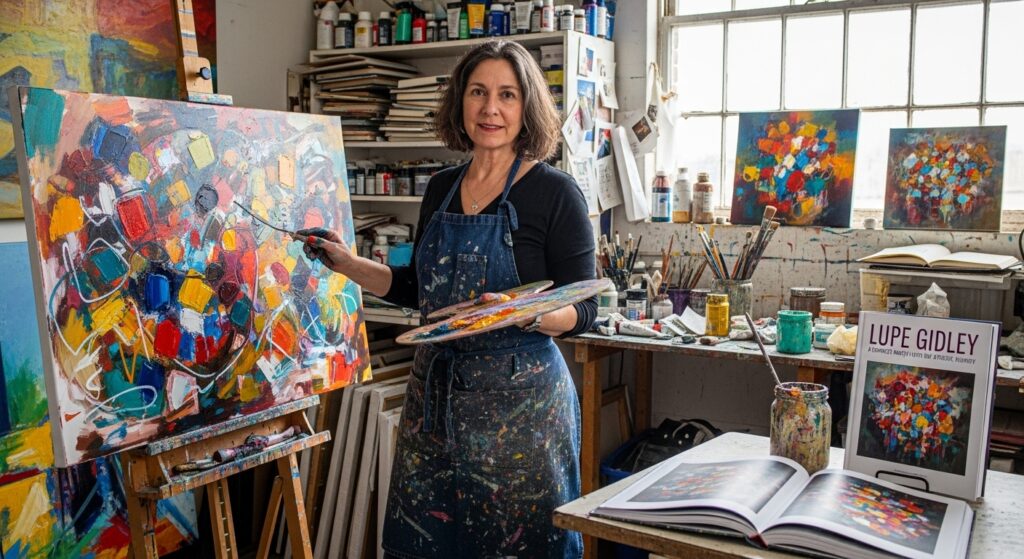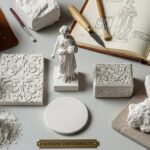In the ever-evolving world of contemporary art, few artists embody both vibrant emotion and thoughtful precision as authentically as Lupe Gidley. Her work bridges the divide between fine art and human experience, using color, texture, and narrative to explore themes of identity, transformation, and emotional truth.
Over the years, Lupe Gidley has developed a distinctive voice — one that reflects her personal journey as much as her creative evolution. Her paintings are not just visual experiences but emotional landscapes, inviting viewers to engage with art in a deeply personal way.
This article offers a complete insight into her journey — from her beginnings and inspirations to her unique artistic philosophy and modern-day impact on the art world.
Early Life and Background
Lupe Gidley’s path to becoming an artist was as organic as her creative process itself. Raised in a family that valued self-expression and creativity, she discovered her passion for art at a young age. Her fascination with color and human expression became the foundation for a lifelong exploration of the visual arts.
She initially experimented with drawing and mixed media, finding inspiration in everyday life and the emotional nuances of human relationships. The interplay between light, memory, and feeling became an early hallmark of her artistic curiosity.
Her formal education further deepened her understanding of art history and technique, yet she remained committed to developing her own visual language — one that balanced classical discipline with contemporary energy.
Finding Her Voice as an Artist
Lupe Gidley’s emergence as a professional artist was marked by a period of introspection and experimentation. In a world saturated with visual noise, she sought to create art that would pause time — offering viewers a space for reflection.
Her early works often explored emotional duality — the tension between joy and sorrow, presence and absence, strength and vulnerability. Over time, her visual vocabulary expanded, incorporating more abstract elements, richer textures, and bolder palettes.
This evolution was not just technical but philosophical. Gidley began to view painting as a dialogue between herself and the canvas, where every brushstroke carried a story, and every layer revealed a piece of the human condition.
“Art, for me, is not about perfection,” Gidley once noted. “It’s about emotion — the energy that lives beneath the surface.”
Artistic Style and Technique
Gidley’s work is instantly recognizable for its dynamic balance between structure and spontaneity. She often blends figurative and abstract forms, allowing realism and imagination to coexist harmoniously.
1. Color as Emotion
Color plays a central role in her compositions. Deep blues, radiant golds, and warm earth tones frequently appear in her work, symbolizing the complex spectrum of human emotion.
For Gidley, color is not simply aesthetic — it’s psychological and spiritual. She uses it to evoke moods, memories, and transitions. Each hue tells a story, carrying emotional weight that invites the viewer inward.
2. Texture and Layering
Her technique often involves layering paint, gesso, and mixed media, creating a sense of depth and movement. These layers are not only physical but metaphorical — representing time, memory, and the invisible layers of identity.
3. Composition and Form
Gidley’s compositions are deliberate yet fluid. Figures may emerge from abstraction, or disappear into it, blurring the line between what is seen and what is felt. Her brushwork oscillates between delicate restraint and expressive freedom, embodying the dual nature of human experience.
Themes and Symbolism
One of the most captivating aspects of Lupe Gidley’s art is her ability to weave complex emotional themes into visually compelling works.
Identity and Transformation
Many of her pieces explore questions of self-discovery and personal evolution. The shifting forms and layered colors suggest the process of transformation — both emotional and spiritual.
Memory and Time
Gidley’s paintings often feel like echoes of memory, suspended between past and present. Her use of translucent layering captures the way memories fade, overlap, and reappear — much like the process of remembering itself.
Connection and Isolation
Another recurring theme in her work is the paradox of human connection. Her figures — sometimes intertwined, sometimes solitary — reflect the tension between intimacy and independence, belonging and solitude.
Nature as Metaphor
Nature frequently appears as a subtle backdrop or symbolic motif — flowing water, trees, or open skies — serving as metaphors for emotional freedom, growth, and resilience.
Evolution of Her Artistic Journey
Throughout her career, Lupe Gidley has continuously evolved, refusing to be confined by a single genre or label.
The Early Period: Emotional Realism
Her early works leaned toward emotional realism, focusing on human faces and figures rendered with expressive intensity. These portraits captured the subtleties of mood and the unspoken depth of feeling behind each gaze.
The Transitional Phase: Abstraction and Intuition
As her practice matured, Gidley began experimenting with abstraction — simplifying forms, embracing texture, and allowing intuition to guide her process.
This period marked her shift toward a more meditative and experimental approach, where she balanced precision with spontaneity.
The Contemporary Phase: Freedom and Fusion
Today, her work embodies a fusion of disciplines — painting, collage, and mixed media. She continues to explore the boundary between the personal and the universal, crafting pieces that feel both intimate and timeless.
This freedom has allowed Gidley to expand her audience and exhibit in diverse spaces — from contemporary galleries to cultural institutions that celebrate women in art.
Exhibitions and Recognition
Lupe Gidley’s work has been featured in numerous exhibitions across the United States, drawing acclaim from both collectors and critics. Her art has appeared in solo and group shows, each revealing a different facet of her creative spirit.
Her exhibitions are often immersive experiences, designed not just to display art but to invite reflection. Viewers describe her shows as deeply emotional, often leaving with a renewed sense of awareness and connection.
Gidley has also collaborated with various art foundations, cultural events, and community projects that promote creativity as a tool for healing and empowerment.
Her contributions have positioned her as a respected voice in the contemporary art landscape, particularly among artists who champion authenticity and emotional resonance.
The Creative Philosophy
At the core of Lupe Gidley’s practice is a belief in the transformative power of art. She views creativity as both a personal necessity and a universal language.
“Painting is how I understand the world,” she says. “It’s how I translate emotion into something tangible — something that others can feel, even if they can’t explain it.”
For Gidley, the act of creation is not about control but surrender — trusting intuition and allowing the process to unfold naturally. She often describes painting as a dialogue, where each brushstroke responds to the one before it, forming a rhythm between chaos and clarity.
This philosophy gives her work a raw honesty that resonates deeply with audiences seeking authenticity in contemporary art.
Influences and Inspirations
Gidley’s artistic influences are as diverse as her visual language. She draws inspiration from:
-
Abstract expressionists like Helen Frankenthaler and Mark Rothko, for their emotional intensity and color mastery.
-
Surrealists such as Frida Kahlo and Leonora Carrington, for their exploration of inner worlds and symbolism.
-
Nature and the human psyche, both serving as recurring themes in her creative exploration.
Her travels, cultural experiences, and introspective practice all feed into her art — making it a living reflection of her journey as both an artist and a human being.
Impact and Legacy
Lupe Gidley impact extends beyond her individual works. She represents a growing movement of artists who use their platform to encourage emotional awareness, authenticity, and mindfulness in art.
Her work invites viewers to slow down, feel deeply, and reconnect with themselves — a rare and vital experience in today’s fast-paced digital culture.
Collectors admire her not only for her technical skill but also for her emotional intelligence — her ability to translate complex feelings into form and color.
Through exhibitions, workshops, and collaborations, Gidley continues to inspire emerging artists to explore vulnerability as strength, reminding them that true artistry begins with honesty.
Conclusion
Lupe Gidley is more than a contemporary artist — she is a storyteller of emotion, a weaver of memory, and a seeker of truth through color and form.
Her journey reflects what art truly means in the modern world: not a product, but a process of discovery.
From her early explorations of realism to her current abstract expressions, she has remained committed to authenticity — to creating art that moves beyond aesthetics and touches the soul.
In a time when art often rushes to impress, Lupe Gidley invites us to pause, reflect, and feel. Her work reminds us that beauty is not just seen — it’s felt deeply, remembered quietly, and shared endlessly.






